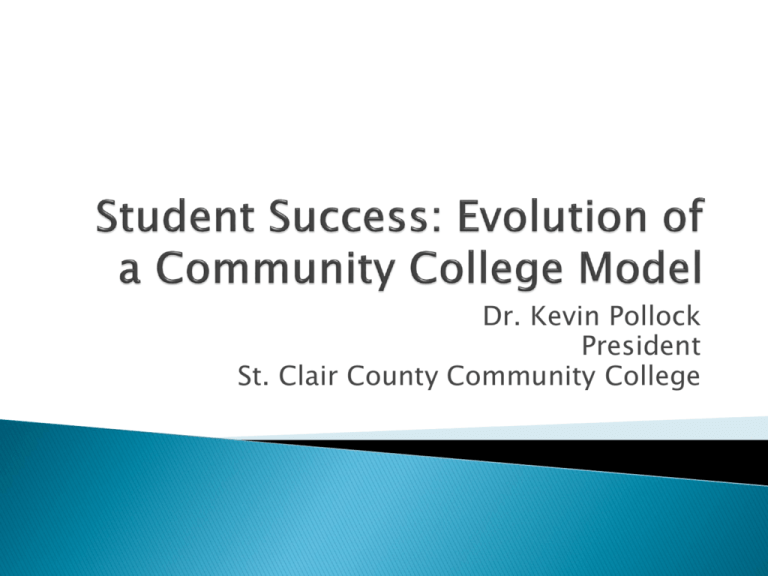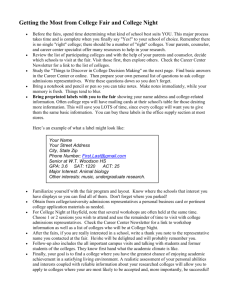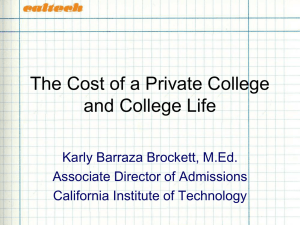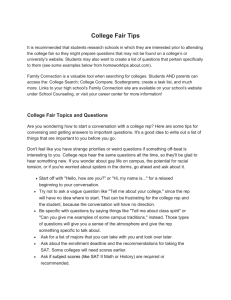
Dr. Kevin Pollock
President
St. Clair County Community College
Response to outside
“drivers” (state,
community)
Internal “drivers” (staff,
students, faculty)
Accreditation
Vision and Mission
Assessment
Student Success
concept
AND create a campus
atmosphere of
inclusiveness?
Prepare students for
academic transfer;
Provide vocational-technical
education, continuing
education, developmental
education;
Provide community service
through cultural and
recreational events.
Education is necessary for the maintenance of
a democracy;
Education is essential for the improvement of
society;
Education helps to equalize opportunities for
all people.
Rouche, J. (1993). Between a Rock and a Hard
Place. American Association of Community
Colleges.
Evolution of the community college now
includes such things as distance learning and
open admissions policies that ensure no
member of the community need miss the
chance to attend.
Community colleges are now involved in
leadership strategies for community,
economic, and workforce development.
Responsibility for academic
transfer preparation
Vocational-technical
education
Developmental education
and community service
Remediation in basic
academic and workplace
skills
English as a second
language
Training in technology
Continuing education and
enrichment programs
How many of these items
identify at-risk students?
“Community colleges have
long been caught between a
rock and a hard place – trying
to provide access and
opportunity for all who can
profit, while maintaining
academic standards in the face
of increasing
underpreparedness”.
John Rouche
Between a rock and a hard
place: the at-risk student in
the open door college
Access
Community Responsiveness
Clear focus on student learning
Resourcefulness
Entrepreneurial Spirit
Creativeness
Innovativeness
Dr. George Boggs
President of American Association of Community
Colleges
Inadequate Financial
Support
Increasing Student Costs
(tuition hikes)
Financial Aid policies (Loans
versus Grants)
Challenges to Image
(Second class?)
Problems with
transferability
Dr. George Boggs
President of American
Association of Community
Colleges
Access (Turning away students by not being
able to offer enough sections)
Student Success (Beyond Access)
Accountability
Dr. George Boggs
President of American Association of
Community Colleges
Chronic
versus
(and) Crisis
Situations
National Issues
◦ P-20 Concept
◦ U.S. Dept. of Ed Action Plan for Improving Measures of
Postsecondary Student Success (Obama Initiative)
◦ AACC Completion Agenda
State Issues
The “Basics” of Enrollment Management: create a
plan, work with faculty, increase retention,
connect students to the campus, etc.
A lot of information available based on “fouryear” models; tougher for “two-year” colleges
What does this mean for us?
Let’s take it step by step
1.
2.
3.
4.
5.
6.
7.
8.
9.
10.
The “Open Door” and its ramifications;
Needs of nontraditional students;
Needs of the Employed student;
Accountability;
The opportunities and attainment gap;
Remediation and basic skills;
Transfer and articulation;
Noncredit and workforce development;
Financial aid;
Supportive learning environments.
“Four out of every ten college students are parttime”
“Seventy-five percent of today’s students are
juggling some combination of families, jobs, and
school while commuting to class”
“Only one quarter go full-time, attend residential
colleges, and have most of their bills paid by their
parents”
“Part-time students rarely graduate; only a quarter
ever make it to graduation day”
“Students are taking too many credits and take too
much time to graduate”
“Remediation is broken, producing few students
who ultimately graduate”
Startling statistics:
Time is the Enemy
Complete College America
Copyright © 2011 Complete College America. All rights reserved.
Copyright © 2011 Complete College America. All rights reserved.
Copyright © 2011 Complete College America. All rights reserved.
Copyright © 2011 Complete College America. All rights reserved.
Remedial education is a fixture in community
colleges with 95% of community colleges
offering remedial classes
42% of entering students are underprepared
in at least one of the basic skills (reading,
writing, math)
Mathematics is the greatest hurdle
No One to Waste McCabe (2000)
“One who is financially
independent, attends
part time, works full
time, delays
enrollment after high
school, has
dependents, is a single
parent, or does not
have a high school
diploma”.
Kay McClenney
League for Innovation
FALL SEMESTER CAMPUS UPDATE
Accountability – Coming Attractions:
Voluntary Framework of Accountability
College Readiness Measures
Report of % of students referred to developmental education (DE) who:
-attempt first math or English/reading DE course;
-complete highest level math/English/reading DE course;
-complete first college-level course in math/English/reading
-complete all DE courses
Progress Measures
Report of % of students who:
-successfully complete in term one;
-reach credit threshold by end of year two
-are retained from fall of term one to next academic term;
-who reach year two outcomes;
-who successfully complete at end of year two
St. Clair County Community College
September 9, 2011
FALL SEMESTER CAMPUS UPDATE
Accountability – Coming Attractions:
Voluntary Framework of Accountability
Outcomes and Success Measures
Report on students who:
-earn an associate’s degree – without transfer and with transfer;
-who earn a certificate – without transfer and with transfer;
-who transfer to a 4-year with no degree or certificate;
-who laterally transfer.
St. Clair County Community College
September 9, 2011
Pennsylvania
community colleges
have become the first
statewide system in
the country to adopt
the Voluntary
Framework of
Accountability created
by the American
Association of
Community Colleges.
FALL SEMESTER CAMPUS UPDATE
Accountability – Coming Attractions
National Community College Benchmark Project
12 Colleges in Michigan currently reporting on 130 metrics including the
following
Student and Student Outcomes
-Fall to Spring and Fall to Fall persistence rates
-Educational goal attainment
-Institution-wide grade information
-Developmental course retention and success rates
Institutional Effectiveness
-Average credit section size
-Student/faculty ratio
-Instructional faculty load
-Cost per credit hour and FTE student
Community and Workforce Development
-Market penetration rates
-Business and industry productivity
St. Clair County Community College
September 9, 2011
Outcome measures
◦ Degrees awarded annually (number and change
over time)
◦ Graduation rates
◦ Transfer rates
Progress measures
◦
◦
◦
◦
◦
◦
Remediation (entry and success)
Success in first-year math and English
Credit accumulation
Retention rates
Course completion
Time and credits to degree
In
God we
trust, all
others
bring
data.
Indiana’s State
Commission for
Higher Education’s
goals
Double the number of
graduates by 2025
Increase on-time grad
rates to at least 50%
at four-year schools
and 25% at two-year
schools by 2018.
Community College Week April 2,
2012
We are being asked to “prove” that learning is
happening;
We are being asked to provide data;
We are asked how we do business and how
we compare to other institutions;
We are asked: how many students are in a
class, why don’t we have more classes on
Friday and weekends, why isn’t there more
financial aid, why does it cost so much?
We have local people who wonder about the
use of their tax dollars.
Governor proposal
on degrees in STEM
Senate proposal
based on contact
hours, local strategic
value, administrative
costs, 4 of 5 goals
certified by board
House proposal
helps pay down
retirement
Make higher education universal;
Create community compacts for educational
attainment (partnerships)
Improve institutional completion measures;
Expand opportunities for “Early College”
achievement (dual enrollment)
Improve the transfer process and award dual
degrees (transfer wizard)
Target adults seeking to complete
postsecondary credentials.
We are in the middle;
We are hearing things
we have been saying for
years;
We are experts in many
ways;
We need to inform our
co-workers why these
issues are important
and how this affects
them
We need to adjust what
we do as well as take a
stronger leadership role
More data
A greater focus on students and their success
Less funding
More rules
Questions like, “Who gets credit for
graduates”?
Transfer issues
What can we do about all of this?
Does this mean change?
“Students
Finish What
They Start”
Tallahassee
Community College
Student
Access to
Student
Success
Are we student-first oriented?
Honestly ask ourselves, “Are we
more concerned if our decisions
impact our students or us?
Is our quality movement working
“under the radar”?
Fairly new to quality
improvement, student success.
Do we have a definition and
measurement?
Are we adverse to cultural
change?
We will have limited resources
Accreditation
How are we responding to
internal and external drivers?
One definition: “Students attaining their
educational goals in the most efficient
manner”.
Student Success is the elimination of barriers
that hinder students from accomplishing their
educational goals.
Student Success is NOT the lowering of
academic standards.
A strong student success model will help
raise retention rates
Mobilize the silent
majority (minimize the
doom and gloom)
Change the culture
Establish that
everybody makes a
difference
Recognize that we are
in the education field
because we care about
students
“Do
the right
thing for the
right reason
and when in
doubt, lean
toward the
student”
Take the lead
Stand up and speak
Utilize data;
Keep the focus on
student success;
Realize you have to
help others
understand what
student success is all
about;
Ask, “who can we
help”?
Classes that don’t
transfer
Dual enrollment
credits that don’t
transfer
Programs that don’t
align so students
transfer before
completing a degree
Transcript issues –
should they be
standardized?
UIC – Unique
Identification Codes
Portability
How agreements are
maintained
Direct credit issues
Clean agreements
Seamless transfers
Advising issues
Understand SEM (or student success)
What is the potential for your campus?
Define the reasons for pursuing student
success?
What are the issues?
Is the rationale cogent and clear?
What are we facing: high school decline,
student satisfaction, large retention issues,
financial?
Define a role in transfer issues (president to
president)
Recruiting?
Advising?
Mentoring?
Attending programs?
Learning outcomes and assessment of classes and
programs?
Developmental Education?
Working with K-12?
A student friendly class schedule?
Working with peer faculty from other institutions on
transfer agreements
Program Review
Accountability
What else?
To receive faculty buyin they need to be part
of the process
A great opportunity for
faculty to see the “big
picture”
An opportunity to work
with others outside of
their department and
share their expertise
Decisions must be data
driven
Every
course,
every program,
every college
is perfectly
designed to
get the results
it is currently
getting.
“Take nothing on its
looks; take
everything on
evidence. There’s
no better rule.”
Charles Dickens (1812-1870)
◦ - Great Expectations
How is our customer
service?
How well do our
students get through
our maze?
Are we looking at all the
things that affect
students?
How well do we work
with our partners?
How well do we work
with our colleagues?
Are we trying to be
great at what we do?
Have a winning attitude
Make a commitment to the customer
Use proper grammar and enunciate
Work on oral communication skills
Increase your phone ability
Develop stronger listening skills
Use different problem-solving techniques
Have the confidence to deal with difficult
customers
Manage job stress
Exceed customer expectations
Recruitment
Application
Admission
Orientation (mandatory?)
Testing and course
placement
Scheduling
Registration
Bill payment
Book purchases
Advising
Financial aid
Mentoring
Online issues
Examine course availability
Correct course placement
Do courses “line up”?
Ask yourself honestly, “Is the schedule done
in the best interest of the students or the
faculty”?
Identify high risk courses
Identify killer combinations of courses and
ask why we allow students to take them
Create and enforce a campus attendance
policy
Advising – the volume of students, bad advice
Do you track success through data and
interviews?
Do you have a student success class?
◦ One or three hours long?
◦ Required or not?
Time management issues
◦ Related to study time
◦ Related to family time
May have difficulty in assessing the value of an
education;
May regard public education as a form of
entitlement rather than a good or service;
May not have as much of a choice in public
education compared to most goods and
services;
May lack access to third-party ratings of public
education services;
May not realize that the burden of success lies
with them;
May not recognize that classmates can affect
their individual level of benefit.
Learning the norms of campus culture
Finding a niche
Putting down roots
Transferring successful behaviors from other
settings
Developing focus
Resisting peer pressures
Compartmentalizing family and work pressures
Exhibiting classroom habits of successful students
Building relationships with teachers
Asking for help
Levitz, R. S., Noel, L., & Richter, B. J. (1999). Strategic moves for
retention success. New Directions for Higher Education (108), 3149.
More students take online
classes than ever before
Digital divide between
students at community
colleges
Use technology to
streamline institutional
functions such as
application process,
registration, orientation,
advisement, and
assessment
Use web sites to deliver
what students need, not
what faculty and staff
desire
Instructional programs (relevant programs and
content, concerned faculty, appropriate technology,
student friendly class schedule, academic support
system);
Institutional policies and structures (early alert,
mandated testing and placement, learning
communities, standards of academic progress;
Institutional culture (service excellence,
engagement, connection, student centered
philosophy);
Services and support (advising, tutoring, financial
aid, counseling supplemental instruction).
Know why our students don’t succeed or leave;
Eliminate barriers that impede success for our
students;
Feel that we have done everything possible in
terms of supporting our students;
Be able to measure our success;
Not point fingers; this is a campus-wide effort
Be able to provide data and answers to questions
raised locally, state-wide, and nationally;
Realize that we are going to be held to a higher
level of accountability.
Create a culture of responsibility, high
standards, and clear expectations;
Provide a deep and broad array of student
support services;
When in doubt lean in the direction of the
student;
Recognize that students are much more than
customers, but recognize that they are also
customers;
Create a student processes taskforce.
The success of our students is the
responsibility of all of us;
We need a comprehensive systematic effort;
We need to have students feel connected to
the campus, supported, and integrated into
the campus community;
We need to understand why students depart.
Use data to help, not
to hurt
Have a passion for
your work
Be tenacious
Stay Strong
Be supportive
Take a more active role in the direction of the
institution
Use data
Be a team
Work in harmony
Listen to what is going on around you
We can all be right separately but wrong
together
Remind everybody that it is all about the
students
810-989-5545
kapollock@sc4.edu






